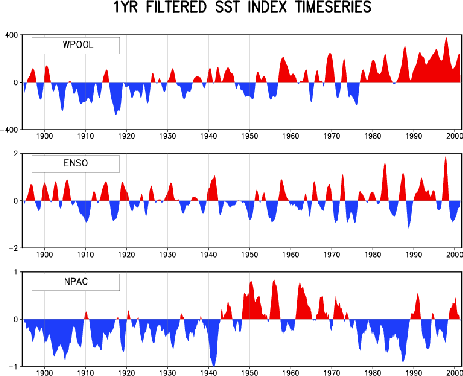Decadal Climate and Global Change Research
The Climate Diagnostics Center contributes to understanding the variations in Earth's climate system on decadal to centennial time scales. Research includes process and model simulation studies to elucidate the relation between changes in the atmosphere and those in the ocean. CDC scientists seek to provide physical and dynamical understanding of observed long term climate variations and change through analysis of hierarchies of designed GCM experiments. These include atmospheric models forced by SSTs, ocean models forced by wind stress, and coupled ocean-atmosphere GCMs, including runs forced by greenhouse gases.
Our investigations have focused on determining fundamental processes responsible for decadal climate variability and change, and assessing whether the latter are due to human influences or natural variability. According to the Third Assessment Report of the IPCC, it is now very likely that global temperatures during the 1990s were the highest since 1861. The same appears to be true for tropical sea surface temperatures, and the areal coverage of the so-called oceanic warm pool (SSTs > 28.5C) (Fig. 5.1, top). CDC scientists are diagnosing relationships between this tropical ocean warming, the global atmospheric circulation and recent climate change.
CDC is engaged in understanding how slow changes in climate affect interannual variability. One key question is determining whether the warm pool change over the equatorial west Pacific impacts the statistics of El Niño/Southern Oscillation (ENSO) in the eastern Pacific. It is evident that the strongest El Niño events in the instrumental record have occurred in recent decades (Fig. 5.1, middle); we are assessing if this is a signature of climate change or merely random fluctuations. The global impacts of ENSO have also changed in recent decades. A fundamental question being pursued at CDC is whether the ENSO teleconnections diagnosed from historical data of the 19th and 20th centuries will be accurate depictions of ENSO impacts in this new, unique century of human induced climate change.
CDC scientists are also studying the origin and climatic impact of midlatitude ocean changes. Most dramatic among these is the multi-decadal variability in SSTs over the Pacific poleward of 30N (Fig. 5.1, bottom), an index of which has been termed the Pacific-Decadal Oscillation (PDO). The apparent long time scale of this oceanic behavior is quite different from that of the ENSO time series. Nonetheless, our analysis shows a strong relation between the two on interannual time scales, and an intriguing question is the extent of their coupling on multi-decadal scales. Likewise, the low frequency variations of North Pacific SSTs since 1950 have atmospheric counterparts, including changes in the oceanic storm track and the strength of the upper tropospheric westerly jet. CDC scientists are studying the nature of air-sea interaction over the North Pacific, and assessing to what extent the diagnostic relations mentioned above entail predictability.
